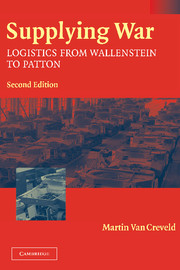Book contents
- Frontmatter
- Dedication
- Contents
- Maps
- Preface
- Introduction
- 1 The background of two centuries
- 2 'An army marches on its stomach!'
- 3 When demigods rode rails
- 4 The wheel that broke
- 5 Russian roulette
- 6 Sirte to Alamein
- 7 War of the accountants
- 8 Logistics in perspective
- Postscript: Where are we now?
- Note on sources
- Bibliography
- Notes
- Index
2 - 'An army marches on its stomach!'
Published online by Cambridge University Press: 22 June 2023
- Frontmatter
- Dedication
- Contents
- Maps
- Preface
- Introduction
- 1 The background of two centuries
- 2 'An army marches on its stomach!'
- 3 When demigods rode rails
- 4 The wheel that broke
- 5 Russian roulette
- 6 Sirte to Alamein
- 7 War of the accountants
- 8 Logistics in perspective
- Postscript: Where are we now?
- Note on sources
- Bibliography
- Notes
- Index
Summary
The end of siege warfare
It may be that no fanfares greeted Napoleon's decision of August 1805 to go to war against Austria. However, in the annals of military history, his campaign marks the transition from the eighteenth to the nineteenth century. Brilliant and even novel as the future Emperor's early exploits may have been, they belonged, in more ways than one, to the previous age. In 1805 his strategy changed, and what subsequent critics were to term Vernichtungsstrategie was born and came of age at one and the same moment. It is not easy to say just what constituted Napoleon's new style of warfare; too many factors were involved for a simple definition to be possible. Much has been written about the ‘new’ and ‘democratic’ character of the French army of the time, whose impregnation with a revolutionary ideology endowed it with an altogether new type of driving force, and about Napoleon's singleminded concentration on the defeat of the enemy's army instead of the attainment of geographical objectives, and his determination to wage war d outrance, to break his opponents’ heads rather than chopping off their limbs. That there is much truth in every one of these explanations none would deny, yet they seem to ignore the central point; namely that, in order to adopt a ‘new’ system of strategy, it is necessary first of all to find new means to carry it into practice. It is above all on these means that the present chapter will concentrate.
Owing to the enormous size of the forces under his command, the logistic problems presented by Napoleon's new strategy were of an order of magnitude that was altogether new. We have already tried to show that long strategic marches were, even in the eighteenth century, by no means as impossible to carry out as is usually assumed. If they were invariably small scale affairs, this cannot be attributed primarily to logistic considerations. Rather, the difficulty was that, whereas the relationship between offence and defence was such that one field army could engage another of equal size with reasonable hope of success, a numerical superiority of no less than 7:1 was thought necessary in order to besiege a strong, well-defended fortress. Therefore such an operation could only be engaged on by a large force, e.g. the 120,000 men that Marlborough concentrated round Lille in 1708.
- Type
- Chapter
- Information
- Supplying WarLogistics from Wallenstein to Patton, pp. 40 - 74Publisher: Cambridge University PressPrint publication year: 2004

